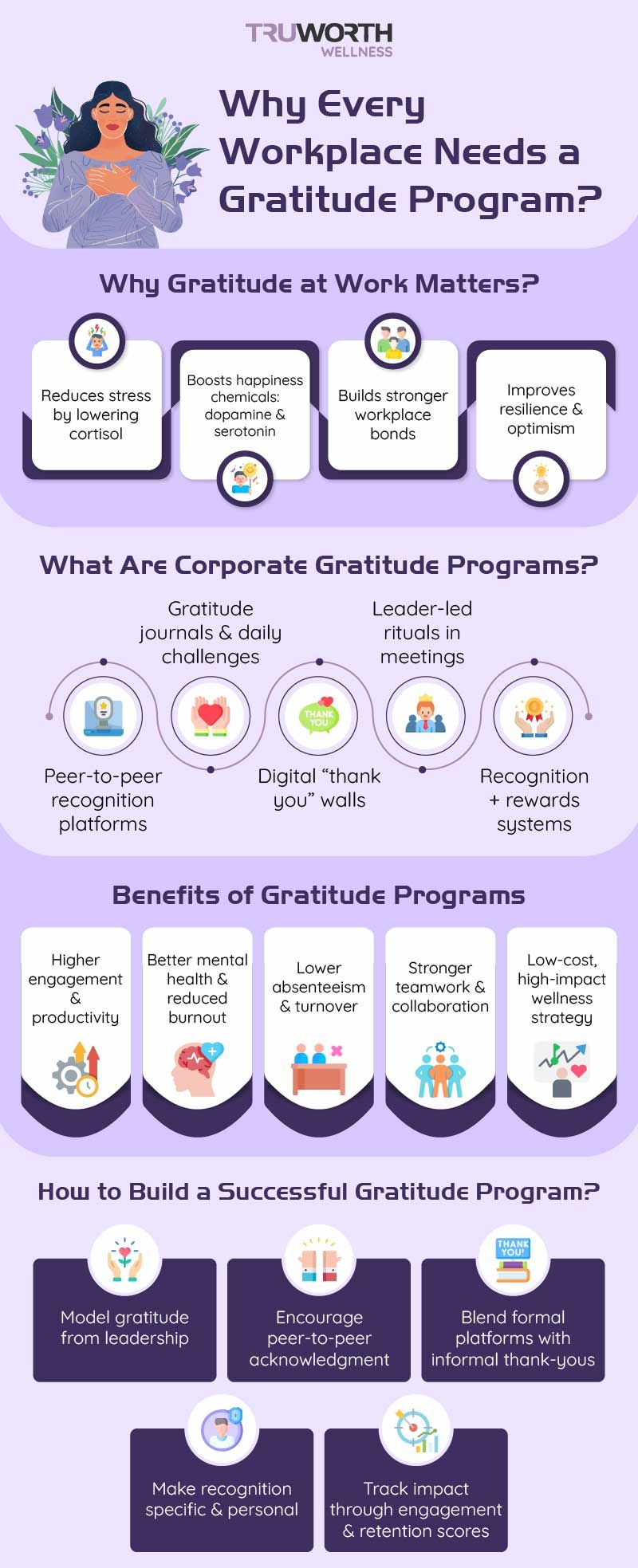The Smallest Workplace Habit That Delivers The Biggest Wellness Wins

Imagine walking into your office on a Monday morning. Instead of the usual rush, you’re greeted with a simple but heartfelt “thank you” from a colleague who noticed the effort you put into last week’s presentation. That moment, though small, instantly uplifts your mood. This is the power of gratitude.
Today, corporate gratitude programs are emerging as one of the most underrated yet effective employee wellness strategies. Beyond gym memberships and yoga apps, organizations are learning that consistent acknowledgment and appreciation can significantly boost workplace wellbeing, productivity, and retention. Gratitude is no longer just a feel-good act—it’s becoming a strategic corporate wellness hack.

Why Gratitude is More Than Good Manners?
In the corporate world, stress is often worn like a badge of honor. Yet, prolonged stress leads to burnout, disengagement, and attrition. Gratitude offers a refreshing counterbalance.
Scientific research shows that gratitude:
- Activates the brain’s reward pathways, releasing dopamine and serotonin—the “happiness chemicals.”
- Reduces cortisol levels, thereby lowering stress.
- Builds resilience and optimism, enabling employees to bounce back from setbacks.
- Strengthens workplace bonds, which directly impacts collaboration and team performance.
Simply put, gratitude is not fluff. It’s a neurochemical booster for workplace wellbeing, and companies that overlook it are missing out on an untapped reservoir of engagement.
What Exactly Are Corporate Gratitude Programs?
A corporate gratitude program is a structured initiative designed to make appreciation part of the organizational culture. While thank-yous often happen organically, these programs ensure that gratitude is consistent, visible, and deeply embedded in everyday practices.
Examples include:
- Peer-to-Peer Recognition Platforms: Employees can send public thank-you notes or digital “kudos.”
- Gratitude Journals & Challenges: Teams track daily or weekly things they’re grateful for.
- Appreciation Boards: Digital walls where acknowledgments are posted for everyone to see.
- Leader-Led Rituals: Managers start meetings by appreciating contributions.
- Recognition + Rewards Systems: Combining gratitude with small perks, like vouchers or wellness points.
Unlike traditional wellness programs focused solely on physical health, gratitude programs directly target emotional fitness and psychological safety, making them far more holistic.
Gratitude as a Wellness Hack: The Overlooked ROI
Why are organizations suddenly investing in gratitude-based initiatives? Because the return on investment is compelling.
1) Boosts Employee Engagement
Recognition makes employees feel valued, which translates into higher commitment and lower disengagement. Engaged employees are 21% more productive, according to Gallup.
2) Strengthens Mental Health
Corporate burnout is a global crisis. Gratitude reduces anxiety and depressive symptoms, promoting a healthier state of mind.
4) Reduces Absenteeism and Turnover
Employees who feel appreciated are more loyal, cutting down attrition—a key metric in HR wellness analytics.
5) Fosters Collaboration and Innovation
When employees trust one another through a culture of gratitude, they are more open to sharing ideas, leading to better teamwork and innovation.
6) Low-Cost, High-Impact Strategy
Unlike costly wellness perks, gratitude requires little to no financial investment. Yet, its benefits rival the most sophisticated wellness programs.
In short, gratitude is a wellness hack hiding in plain sight.
Challenges: Why Gratitude Sometimes Fails in Corporates?
Despite its simplicity, gratitude programs can backfire when executed poorly. Common pitfalls include:
- Superficial Recognition: Digital badges or “auto-generated” thank-yous that feel transactional.
- Lack of Leadership Buy-In: If leaders don’t genuinely model gratitude, employees won’t either.
- Perception of Compensation Replacement: Gratitude cannot replace fair pay, benefits, or manageable workloads.
- Cultural Misalignment: In some organizations, public recognition may feel uncomfortable or forced.
The key to success lies in authenticity and cultural sensitivity. Gratitude should not feel like a checkbox—it should feel like a value.
Building an Effective Gratitude Program: A Step-by-Step Guide
For gratitude to evolve into a true wellness driver, companies must approach it strategically:
1) Start with Leadership
Executives and managers should consistently express genuine appreciation. When leaders model gratitude, it cascades throughout the organization.
2) Empower Peer Recognition
Gratitude shouldn’t only flow top-down. Peer-to-peer acknowledgment ensures inclusivity and authenticity.
3) Blend Formal and Informal Practices
Structured programs (like recognition platforms) should be balanced with spontaneous, personal thank-yous.
4) Encourage Storytelling
When appreciation is tied to specific actions (“Thank you for staying late to fix the client deck”), it feels more meaningful and personal.
5) Integrate with Wellness Platforms
Tie gratitude points to wellness apps where employees can redeem them for health benefits or wellbeing rewards.
6) Track and Measure Impact
Use surveys, engagement scores, and retention data to evaluate the effectiveness of gratitude initiatives.
By making gratitude measurable, companies elevate it from a “soft skill” to a tangible corporate wellness metric.
Global Trends: How Companies Are Using Gratitude?
- Google encourages peer-to-peer recognition through its “gThanks” program.
- Salesforce ties employee recognition with wellness benefits.
Indian corporates are increasingly adopting gratitude rituals in team meetings, given the cultural value placed on respect and acknowledgment.
These examples show gratitude is not just a Western concept—it’s adaptable across cultures when tailored properly.
Gratitude and the Future of Corporate Wellness
Wellness is shifting from a focus on physical fitness (step counts, BMI, gym challenges) to emotional sustainability. Gratitude stands at the forefront of this evolution.
In the future, we may see:
- Gratitude integrated with AI-powered HR platforms to suggest timely recognitions.
- Gratitude-based KPIs, tracking kindness and recognition as serious corporate metrics.
- Hybrid workplaces using gratitude to maintain culture despite physical distance.
Gratitude may soon become as essential as performance reviews in shaping corporate success.
Conclusion
Corporate wellness is no longer about expensive perks or flashy programs. Sometimes, the smallest actions create the biggest shifts. Gratitude—simple, authentic, and consistent—is proving to be a powerful wellness hack that enhances mental health, strengthens teams, and drives business outcomes.
In a world where professionals are striving for balance and meaning at work, perhaps the next big wellness revolution will come from two small words: thank you.
At Truworth Wellness, we help organizations design employee wellness programs that go beyond fitness and diet. From gratitude-based recognition systems to holistic emotional wellness solutions, our programs are tailored for modern workplaces that value both performance and people. Let’s create a culture where appreciation fuels success.